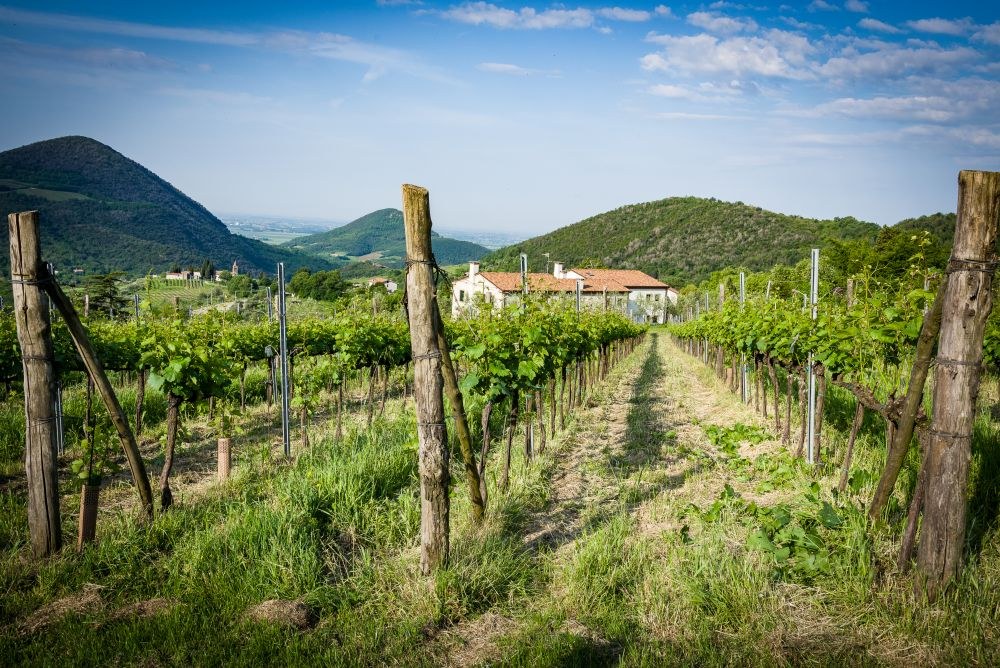Roverello: history of a Chardonnay in the Euganean Hills

Before telling the story of our Roverello and of Chardonnay in the Euganean Hills, let's get to know better the grape variety itself.
"Chardonnay is an international grape, cultivated all over the world and appreciated for its good adaptability to the terroir where it is cultivated. It originated from a spontaneous crossing between Pinot Noir and Gouais Blanc in Bourgogne, and it is from this area (Chablis) that the first great white Chardonnay wines came from.
Thanks to its pleasant nature, it spread quickly all over the world, becoming the symbol of both great still white wines and the most renowned classic method sparkling wines: Champagne, Franciacorta, Trentodoc.
The arrival of Chardonnay to the Euganean Hills
Chardonnay appeared in the Euganean Hills around the 1980's. The viticultural fashion of the period led to the uprooting of autochthonous and rustic varieties in favour of more "elegant"" and appreciated grapes. At the time, if a producer wanted to produce white wines of certain importance, the only choice was Chardonnay, often following the same vinification style used by our French cousins: malolactic fermentation in oak casks, aging for at least one year with frequent batonnage in order to increase smoothness and sinuosity to the taste.
In the Euganean Hills, it was initially confused with Pinot Bianco, from which it differs for its marked tendency to wood up the shoots and stem and for the different conformation of the petiolar sinus (the attachment of the leaf to the stem): lyre-shaped in Chardonnay, U-shaped in Pinot Bianco.
Thirty years of history for the Chardonnay Ca' Lustra
Many of our Chardonnay vineyards rotated over the years between the slopes of Mount Brecale and the Faedo Valley, always looking for fresh volcanic soils without excessive sun exposure. Being an early-harvest variety, Chardonnay suffers greatly from the ongoing climate change: hot weather and droughts promote accumulation of sugars in the berry (technical maturity) before the skin and seeds are ripe with phenols. This discrepancy in maturation results in alcoholic wines with poor and ""green"" aromas.
While our first Chardonnays date back to the 1990s, the modern Roverello has its origins around 2002. The name “Roverello” comes from the road which runs along the vineyards above our winery. In ancient times, the Faedo Valley was completely covered by woods and the “Roverella” was the most common tree species: a slow-growing oak resistant to both droughts and cold climates. Over the centuries, their roots slowly ground down and fragmented the hard bedrock of trachyte and rhyolite below the hills, generating a fertile soil suitable for cultivation. Exactly on these slopes the first Chardonnay vineyards of the Euganean Hills took root.
The introduction of Chardonnay by Franco Zanovello was a necessary challenge in order to break through and make the Euganean Hills known as a winemaking area. By producing an ""international"" wine, with French-style vinification and aging methods, we aimed at obtaining recognition from the public in other Italian regions, and perhaps even abroad.
It was so that Chardonnay started to be vinified in a completely different way from the other whites of the Euganean Hills, in order to support the imagery of the ""important wine"" against those considered simpler ones. With time, we realized this style of vinification could be revised and applied to almost every white-berried variety. Thus, we challenged over the years the belief that a good white wine could be made only with Chardonnay grapes: many other varieties have established themselves in an excellent way, especially those from high-altitude vineyards.
Our Roverello has been a pure Chardonnay for 30 years: harvested when ripe, fermented in small casks with selected yeasts in the beginning and with indigenous ones later. Aged for one year with batonnage to resuspend the mannoproteins. This is how our Colli Euganei DOC Chardonnay 1998 was presented: ""Generous white, with a bouquet reminiscent of golden apples and fresh bread crust. Inviting and intense flavour with aromas of acacia honey. Suitable for aging in bottle for 2-3 years, evolving into a noble and pleasant bouquet.""
The Roverello today: a more mineral cut to our Chardonnay
Today, the Roverello has maintained its name, but it is enriched by new grapes that improve its organoleptic characteristics. Starting with the 2017 vintage, we introduced small percentages of Manzoni Bianco and Moscato varieties to complement the Chardonnay. Vinification remains unchanged with the exception of the filtration step: since 2017 our white wines are no longer filtered but left to rest and decant for long time in large cement tanks. This process allows to obtain clean and clear wines, more robust and enduring.
We can describe it as a smooth and sinuous white wine, with intense aromas and a clean and persistent taste. It successfully pairs with white truffle, vegetables au gratin, egg pasta and freshwater fish dishes.
Our experimental work is always on-going, together with the study of our lands. Such attitude allows us to understand our territory, its peculiarities and its best expressions, especially in light of the changing climate. We follow nature every day and try to understand how to produce the best fruits and interpret them respectfully in the cellar.